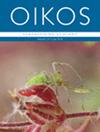维管植物分类和功能的丰富程度对非维管光养群落的影响各不相同
IF 3
2区 环境科学与生态学
Q2 ECOLOGY
引用次数: 0
摘要
尽管非维管束光自养生物(NVPs)具有重要的生态意义,但它们经常被排除在生态实验研究之外,导致人们对其群落如何受生态系统动态影响的理解有限,并低估了它们在生态系统功能中的作用。我们在持续时间最长的植物生物多样性实验(杉溪生态系统科学保护区的生物多样性与生态系统功能)中,研究了维管植物分类和功能多样性对三组地面无脊椎动物(地衣、红叶植物和蓝藻)的影响。利用该实验的永久小区框架,我们分析了近 30 年来不同维管植物分类和功能多样性水平的处理对 NVPs 的影响。对于每个多样性水平,我们都记录了 NVP 的覆盖度和丰富度。利用广义线性模型,我们评估了维管束植物分类和功能多样性以及受维管束多样性影响的环境因素(如维管束植物覆盖度、透光率、土壤养分含量和微地形)对 NVP 丰富度和覆盖度的影响。利用这些模型,我们进行了结构方程建模分析(SEM),从而区分了维管束植物分类和功能多样性对NVP的直接和间接影响。结果表明,随着维管束植物分类和功能多样性的提高,地衣和苔藓植物的丰富度和覆盖度都会降低,而蓝藻的覆盖度则会提高。我们还发现,微地形对地衣和红叶植物的预测作用更好,而营养相关因素对蓝藻的预测作用更好。此外,我们的研究结果表明,在调查的地块中,NVP 的覆盖率从 0.001% 到 100%(平均为 15%)不等,是实验地块中仍被忽视的一个重要组成部分。这项研究表明,维管植物多样性直接或间接地影响着 NVP 群落,但这些影响在群落和生态系统层面的后果仍有待探索。本文章由计算机程序翻译,如有差异,请以英文原文为准。
Vascular plant taxonomic and functional richness differentially affect non‐vascular photoautotroph communities
Despite their ecological significance, non‐vascular photoautotrophs (NVPs) are frequently excluded from ecological experimental studies, leading to a limited comprehension of how their communities are affected by the ecosystem dynamics and an underestimation of their role in ecosystem functioning. We studied the impact of vascular plant taxonomic and functional diversity on three groups of ground NVPs (lichens, bryophytes, and cyanobacteria) within one of the longest‐running plant biodiversity experiments (Biodiversity and Ecosystem Function at Cedar Creek Ecosystem Science Reserve). Utilizing the permanent plot framework of this experiment, we analyzed the effects of almost 30 years of treatment across various levels of vascular plant taxonomic and functional diversity on NVPs. For each diversity level we documented NVP cover and richness. Using generalized linear models we evaluated the effect of vascular plant taxonomic and functional diversity, as well as environmental factors affected by vascular diversity (such as vascular plant cover, light penetration, soil nutrient content, and microtopography) on NVP richness and cover. Using these models, we conducted structural equation modeling analyses (SEM) that allowed us to differentiate the direct and indirect impacts of vascular plant taxonomic and functional diversity on NVPs. Our results showed that both lichen and bryophyte richness and cover decreased with higher vascular plant taxonomic and functional diversity, while cyanobacteria cover increased as a function of the same parameters. We also showed that microtopography serves as better predictor for lichens and bryophytes, while nutrient‐related factors perform better as predictors for cyanobacteria. Additionally, our findings indicate that NVP cover ranged from 0.001% to 100% (mean 15%) in the surveyed plots, representing a major, still ignored, component of the experimental plots. This study shows that vascular plant diversity directly and indirectly affects NVP communities, but the consequences of these effects at community and ecosystem levels are still to be explored.
求助全文
通过发布文献求助,成功后即可免费获取论文全文。
去求助
来源期刊

Oikos
环境科学-生态学
CiteScore
6.20
自引率
5.90%
发文量
152
审稿时长
6-12 weeks
期刊介绍:
Oikos publishes original and innovative research on all aspects of ecology, defined as organism-environment interactions at various spatiotemporal scales, so including macroecology and evolutionary ecology. Emphasis is on theoretical and empirical work aimed at generalization and synthesis across taxa, systems and ecological disciplines. Papers can contribute to new developments in ecology by reporting novel theory or critical empirical results, and "synthesis" can include developing new theory, tests of general hypotheses, or bringing together established or emerging areas of ecology. Confirming or extending the established literature, by for example showing results that are novel for a new taxon, or purely applied research, is given low priority.
 求助内容:
求助内容: 应助结果提醒方式:
应助结果提醒方式:


